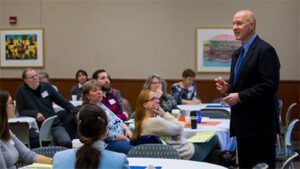Contributed by CTL Faculty Associate, Kelly Mancini Becker
I haven’t really heard the term wicked since my days living in Providence, RI in the early 90s where the term was used frequently to emphasize everything: it was going to be wicked cold this weekend, that outfit is wicked cool, my day was wicked long.
Educator and author, Paul Handstedt, is reviving the word in his recent book, Creating Wicked Students: Designing Courses for a Complex World. What is a wicked student? “A questioning, informed, thoughtful agent of positive change” who can go out into the world and solve complex issues, or what he calls wicked problems (Handstedt, 2018, p. 3). I’ve written this post to both introduce the “wicked” concepts and invite you to a new CTL workshop series (see calendar links below).
What’s a wicked problem?
The notion of a wicked problem, according to Wikipedia, has its origins in the mid-1970s, first coined by West Churchman and expanded by Horst Rittel. In Handstedt’s use of the word, he refers to the work of Edmond Ko, a general education thinker who defined it as a “situation where the parameters of the problem and the means available for solving them were changing constantly” (p. 3).
Sound all too familiar? The Corona virus pandemic was one big, wicked problem. This book was written in 2018, so Handstedt didn’t have this as an example, but it surely fits the bill. In the effort to face, solve, and survive the pandemic, leaders in every sector of society had to think and act in new ways. This issue crossed borders and required politicians, scientists, medical staff, educators, and business owners to work together to create systems to meet the new and constantly changing challenges that the pandemic presented.
As instructors in higher education, we are helping to educate the next generation of leaders, workers, and citizens who will be faced with solving such problems—which leads to the premise of the book: how do we accomplish this and what does it mean for the courses we teach?
Paul Handstedt argues that we need to do more in college courses than teach content and skills. He argues that our students need “authority.” In a sense, he uses this word to allude to “authorship”—to write, create, or build something new and have the confidence to do something that has not yet been done. Authority is also an attitude, “a sense of one’s ability to enter the world not as a mere cog in the machine, but as a thoughtful, competent individual who, when the situation calls for it, is able to step forward to ask questions and propose solutions that may lead to a reinvention of the machine” (p. 5).
So how do we create an opportunity to gain authority in our courses? In what ways do our courses challenge our students to solve problems, be creative, and think in new ways? Handstedt acknowledges that our students need to have some knowledge base before solving problems in their fields, but he argues that we need to move more quickly to application, providing our students with opportunities to practice these skills.
Handstedt argues that “higher-order goals are not a replacement for the basics but, rather, a means of taking foundational material to a more productive level of learning” (p. 20). He challenges us to break down the walls between classroom and world sooner, and to push our students to practice solving complex problems in real world settings. He suggests we shift our thinking about our courses as spaces that allow our students to gain knowledge and hopefully skills, to thinking of them as opportunities for students to gain wicked competencies: more action and application and less knowledge acquisition.
If this sounds interesting, please join for a 3-part workshop series where we explore how to accomplish this through course design using three chapters in Creating Wicked Students as a framework.
During our time together, we’ll workshop ideas to either strengthen our current syllabi or plan a new course by:
- Defining wicked problems in our fields.
- Developing or reworking course objectives to go beyond learning content, but to also develop competencies, deepen learning, and build the capacity for authority.
- Structuring courses in a way that pushes our students to gain authority within a subject area and build their capacity to problem-solve; as the semester builds, the challenges can become more complex.
- Developing assessments and assignments that both test and allow student to solve wicked problems.
CTL Workshop series
- Session 1: Identifying Wicked Problems for Wicked Students
Tuesday April 12, noon-1pm - Session 2: Designing Wicked Course Objectives
Tuesday April 19, noon-1pm - Session 3: Creating Wicked Assignments and Exams
Tuesday April 26, noon-1pm
Feel free to join us for one or all of these sessions. It’s going to be a wicked great learning experience for all!

